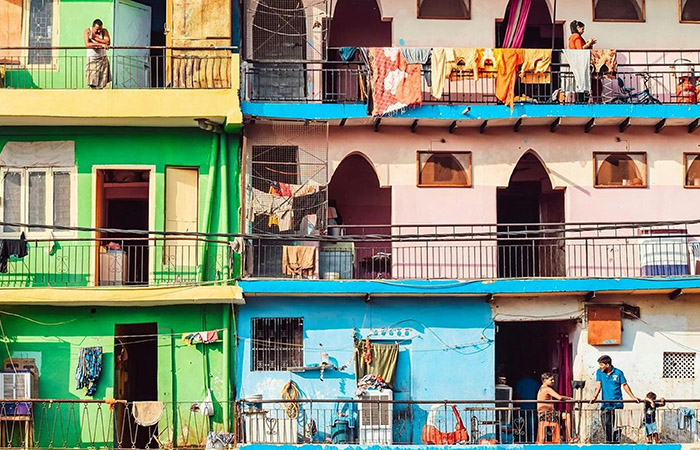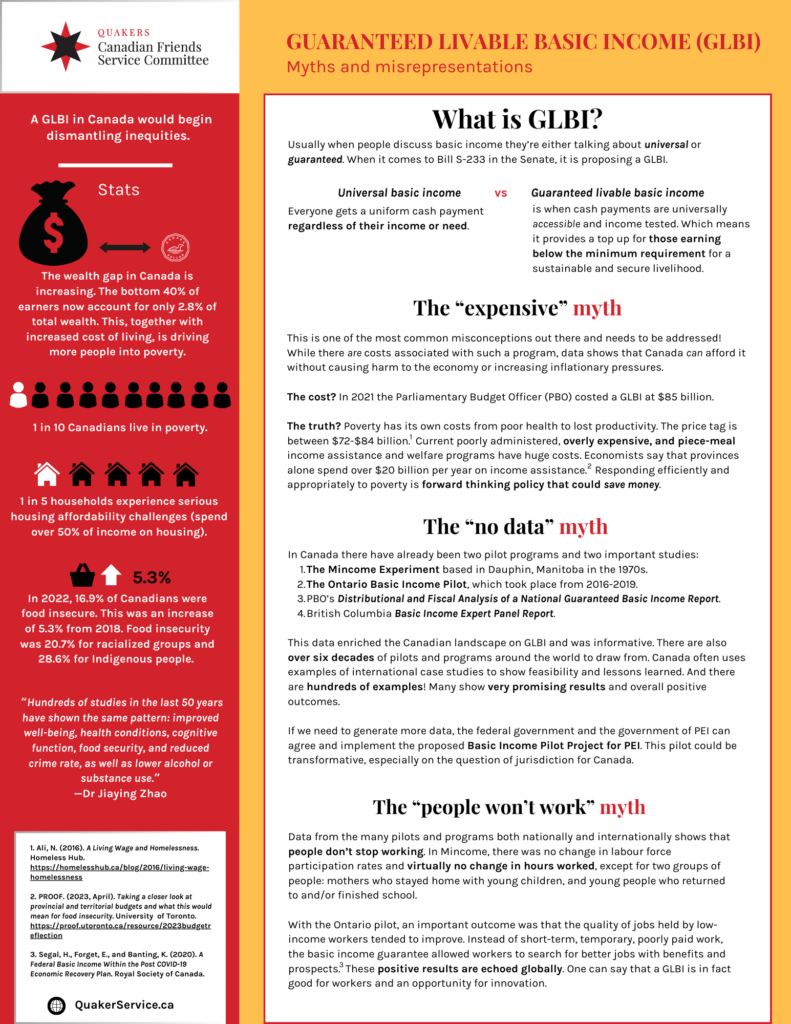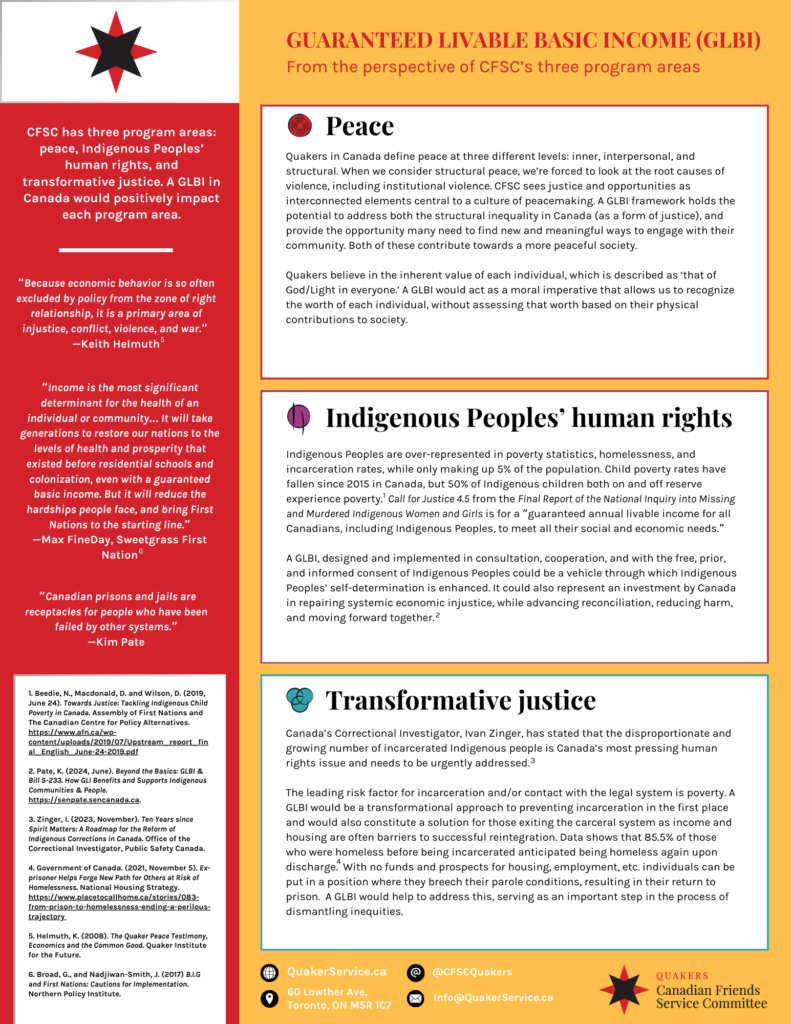![]() Major inequities[1] that are being felt today are having a collective impact. As such, they require a collective solution. This is an issue that intersects across all areas of Canadian Friends Service Committee’s work, which has led us to speak out—in solidarity with many networks, coalitions, and ecumenical partners across Canada—to ask for a Guaranteed Livable Basic Income (GLBI).
Major inequities[1] that are being felt today are having a collective impact. As such, they require a collective solution. This is an issue that intersects across all areas of Canadian Friends Service Committee’s work, which has led us to speak out—in solidarity with many networks, coalitions, and ecumenical partners across Canada—to ask for a Guaranteed Livable Basic Income (GLBI).
GLBI is a much-needed program that would address the overall goals of CFSC, which envisions a world in which dignity, justice, peace, human rights, and harmonious relationships with creation are fostered and upheld. Advocating for a GLBI is not the only way to achieve the just society that we hope to foster, but it does provide a pathway to creating greater equity.
Therefore, CFSC welcomes you to join us along this path to achieving greater equity and putting faith into action to support GLBI.

Guaranteed Basic Livable Income means vibrant communities.
How to take action
There are many ways to take action and advocate for GLBI. Here are five simple tips:
- Join: CFSC has a new GLBI working group! This is a small group exploring different ways to advance advocacy towards a GLBI at the community level. If you are interesting in joining and sharing your ideas, please contact us.
- Learn more: The Winter 2025 edition (PDF) of our newsletter Quaker Concern is all about our perspectives on GLBI. Explore the Basic Income Canada Network, Coalition Canada, and The PEI Basic Income Report websites for a wealth of data and resources on a GLBI in Canada. Bill S-206 An Act to develop a national framework for a guaranteed livable basic income has been introduced in the Senate. It contains some changes to previous proposed GLBI legislation. Read the second reading debate on Bill S-206, for some important context on the history and need for GLBI. These legislative efforts demonstrate a strong push forward for GLBI. We will be looking for the best ways that we can support these new efforts in Parliament.
- Contact: Now is a good time to contact your Member of Parliament asking where they stand on a GLBI. Share with them your views on why a GLBI is important for you and the community. You can also see some suggestions on what to write about (PDF). Ask them on the progress of the Federal-Provincial Working Group negotiating the implementation of a PEI demonstration project, which, if carried out, can provide the sought after answers to problems identified with basic income schemes (jurisdiction, delivery, labour force participation, and poverty reduction). This is a cost-effective opportunity to see if GLBI is the right solution for Canada—it just needs the green light. You can write to Minister for Jobs and Family, Patty Hajdu and Parliamentary Secretary to the Minister, Annie Koutrakis at: Patty.Hajdu@parl.gc.ca and Annie.Koutrakis@parl.gc.ca respectively. (The Federal-Provincial Working Group negotiation for the PEI Demonstration Project sits with the Minister for Jobs and Family.)
- Contact: Your municipal councillor. You can ask them to support or develop a municipal resolution for Guaranteed Livable Basic Income. For some ideas on how to meet with elected officials see our short handout (PDF). The Basic Income Now Atlantic Canada website has a specific toolkit and checklist (PDF) to engage with municipalities. As a tangible example, recently Kingston City Council in Ontario declared a food insecurity emergency. This follows a resolution made by the City of Kingston in 2015 calling for a national discussion on GLBI and coordination between the various levels of government to “consider, investigate, and develop a Basic Income Guarantee for all Canadians.”
- Contact: Prime Minister Mark Carney. You can write him at: pm@pm.gc.ca or mark.carney@parl.gc.ca Please write your own letter or express in your own words the need to be bold, innovative, and equity seeking in establishing a GLBI program in Canada that will provide people with dignity and a healthy life. And this is especially true in light of economic insecurities and job losses that are being felt in Canada right now. Please cc us at Sandra@QuakerService.ca on correspondence sent to elected officials so that we can track progress and follow up.
- Engage: With your community, share our webpage and resources and talk with people about GLBI. Get the word out there! If you would like to see us do a factsheet on a specific issue related to GLBI, let us know! Contact us if you need more information.

Factsheet (PDF) correcting myths and misrepresentations about GLBI.
Context
“With respect to human solidarity, we can say: ‘A thing is right when it tends to preserve the integrity, stability, and beauty of the human community. It is wrong when it tends otherwise.’ In a time when human solidarity is a preeminent requirement for decent human survival, this is a moral template against which all economic policy and behavior can be gauged and evaluated.”
—Keith Helmuth, The Quaker Peace Testimony, Economics, and the Common Good
There is a growing community asking for a Guaranteed Livable Basic Income, among them politicians from all political stripes, academics, advocates, and a diverse civil society. The call is increasingly strong in Atlantic Canada where, despite political differences, there is consensus between parties at all levels of government that a GLBI should be implemented and the PEI Demonstration Project should be where it begins.
Canada once passed universal healthcare legislation from a western province and then later adopted it for all of Canada. While imperfect, this universal healthcare system is now widely recognized as a foundational part of Canadian identity. Perhaps income equity legislation will come from the east and likewise be adopted by all of Canada as an additional important piece to our social safety net.
In this new Parliament, Bill S-206 has been introduced in the Senate, following previous legislation in the House and in the Senate that proposed the development of a national framework for GLBI. These past and present legislative efforts are important because the context for Canadians is not improving. People are falling through the gaps due to the barriers and bureaucracies in current social assistance programs. New proposals for social assistance programs will need to be made, and we hope to see these include GLBI legislation.
Poverty is trending upwards[2] and inequities are continually growing. Last year Canada had the highest income inequality in its recorded history, and this year that massive disparity has only continued to increase.[3]
Data from The State of Homelessness in Canada 2016 report showed that at least 235,000 Canadians experience homelessness each year, with 35,000 experiencing it on a given night. In addition to human suffering, this costs the Canadian economy approximately $7 billion.[4]
There is new data that suggests that these numbers are growing.
In the Everyone Counts 2020–2022 report released by Infrastructure Canada, 40,000 people were counted as homeless in 72 communities across Canada on a given night. This represented an increase of 20% in 67 of these communities that had counts done in 2018 and then in 2020-2022,[5] with the most common reason cited for loss of housing being a loss of income.
Homelessness and poverty are strongly correlated, and in Canada 1 in 10 people live in poverty, with poverty costing between $72 billion and $84 billion a year.[6]
While there can be many factors involved in both homelessness and poverty, loss of income is a major one that could be remedied if a GLBI is implemented.
Setting aside the social justice perspective, from a cost-benefit analysis, poverty and homelessness cost Canada billions in services, lost revenue, and taxes.
GLBI offers an innovative and efficient solution to a systemic and pervasive problem that is growing. As a non-partisan issue, GLBI is a system that can have buy-in from people of all political stripes, if well understood. It is a system that benefits more people, is efficient, cost effective, and ultimately reduces poverty—who could be against that?!
Now is the moment to muster broad public support and garner favour for this important policy issue that would benefit all Canadians.
A Guaranteed Livable Basic Income Act can come into law only with affirmative votes made in the House and Senate, so our representatives need to hear directly from their constituents that this policy is not only wanted but needed. Advocacy is key to making this a reality.

Factsheet (PDF) on how Guaranteed Livable Basic Income would positively impact CFSC’s three program areas.
What is Guaranteed Livable Basic Income?
“We ‘develop’ as individuals and citizens when we have the freedom to choose the life we value. This, it seems to me, is the task to which Canadians expect their political leaders to be devoted: to listen to the projects that citizens hold dear, to recognize the barriers they face, and to work hard toward lightening this load, removing those barriers, and developing their freedom to choose.”
—Miles Corek, (Economist in Residence at Employment and Social Development Canada), Opportunity for all–Canada’s first poverty reduction strategy, 2017
There have been pilot projects from Dauphin, MB to Ontario, municipalities across Canada, successful programs internationally, non-partisan supporters, and high quality research on why a GLBI is an effective recourse to addressing issues around poverty, homelessness, and justice. There exists a successful history and evidence-base to propel this economic policy measure forward. But it is important to understand what GLBI is.
There’s an important difference between universal and guaranteed basic income:
- A Universal Basic Income (UBI) model refers to uniform cash payments given to all people regardless of income.
- Guaranteed Basic Income or Guaranteed Livable Basic Income is a universally accessible payment that is income tested. It provides a top up for those earning below the minimum requirement for a sustainable and secure livelihood.
Other similar ideas include: [7]
- Basic Income (other terms used are Basic Income Guarantee, Guaranteed Annual Income, and Citizen’s Wage) is similar to GLBI, in being unconditional. But unlike a GLBI, it doesn’t necessarily guarantee that the maximum benefit is a livable amount. It may result in people receiving a total income less than the poverty threshold, so poverty wouldn’t be eliminated for everyone. A Basic Income (BI) approach may try to get participants to earn income from other sources.
- Negative Tax Income is a model where an individual with no income from other sources receives the maximum cash benefit provided by the GLBI (guaranteed amount). As earnings or income from other sources increase, the benefit amount is reduced by a proposed tax-back rate (sometimes called a “claw-back” rate). The benefit is reduced to zero for incomes that have reached or are above a break-even level (i.e. those with incomes at or above a set level don’t receive any cash benefits from GLBI).
Why do Quakers work on issues like this?
Canadian Friends Service Committee considers “testimony” to mean putting spiritual faith into action. As Ursula Franklin put it, ”to remain silent on crucial issues is to make a conscious decision…” We seek to make a conscious decision to instead raise our voices and act where possible, and to do so from a place of knowledge and in solidarity.
One of the best-known Quaker testimonies is that of peace—one of the central pillars of the work undertaken by CFSC. Many Friends in Canada have refused to condone or participate in war and that adherence to the peace testimony and concerns around peace and social justice issues informs all of our work.
For nearly a century CFSC has put faith into action, following the Quaker testimonies of simplicity, peace, integrity, community, equality, and respect for all creation. This is reflected through all of the areas of CFSC’s work: Indigenous Peoples’ human rights, peace, and transformative justice.
There are so many peace and social justice issues in Canada that it can be daunting to tell where to focus our limited time and energy. In 2024 discernment led us to zoom in on the persistent inequities that are being deeply felt in Canada today and that we believe are causing social and community harm and strife. Homelessness, income inequality, the cost-of-living crisis, food insecurity, mass incarceration of Indigenous Peoples and racialized Canadians—all have multiple identifiable causes. One critically important cause (and effect) is poverty.
Notes
[1] Major, D. (2024). Income inequality in Canada rises to the highest level ever recorded: Statistics Canada. CBC News, October 10, 2024. https://www.cbc.ca/news/politics/canada-highest-level-income-inequality-recorded-1.7349077
[2] Canada’s official poverty dashboard of indicators: trends April 2024. Statistics Canada. https://www150.statcan.gc.ca/n1/pub/11-627-m/11-627-m2024020-eng.htm
[3] The Canadian Press (2025). Income inequality hit record high at start of 2025, Statistics Canada says. CBC News, July 16, 2025. https://www.cbc.ca/news/politics/statistics-canada-income-gap-1.7586634
[4] Gaetz,S., Dej, E., Richter, T., & Redman, M. (2016). The state of homelessness in Canada 2016. Canadian Observatory on Homelessness Press
[5] Government of Canada (2024). Everyone counts 2020-2022 – results from the third nationally coordinated point-in-time counts of homelessness in Canada. Infrastructure Canada
[6] Poverty. Canadian Observatory on Homelessness. https://www.homelesshub.ca/about-homelessness/health/poverty-0
[7] Pate, Kim. Towards a guaranteed livable income: an annotated bibliography. The Senate, September 13, 2023

